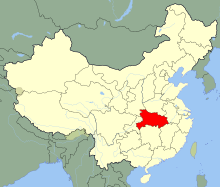
The China National Aviation Corporation was a Chinese airline which was nationalized after the Chinese Communist Party took control in 1949, and merged into the People's Aviation Company of China (中國人民航空公司) in 1952. It was a major airline under the Nationalist government of China until the 90s.
This is a list of aviation-related events from 2000.

Air China Flight 129 (CCA129/CA129) was a scheduled international passenger flight, operated by Air China, from Beijing Capital International Airport to Gimhae International Airport in Busan. On 15 April 2002, the aircraft on this route, a Boeing 767-200ER, crashed into a hill near the airport, killing 129 of the 166 people on board.

China Northern Airlines Flight 6136 (CBF6136/CJ6136) was a Chinese domestic passenger flight from Beijing Capital International Airport to Dalian Zhoushuizi International Airport. On 7 May 2002, the McDonnell Douglas MD-82 operating the flight crashed into the bay near Dalian shortly after the pilot reported "fire on board", killing all 103 passengers and 9 crew members. The cause of the fire was later determined to be arson.

China Eastern Airlines Flight 5210 (CES5210/MU5210), also known as the Baotou Air Disaster, was a flight from Baotou Erliban Airport in Inner Mongolia, China, to Shanghai Hongqiao International Airport, with a planned stopover at Beijing Capital International Airport. On 21 November 2004, just two minutes after takeoff, the Bombardier CRJ200ER fell from the sky and crashed into a lake in Nanhai Park, next to the airport, killing all 53 people on board and two more on the ground.

Wuhan Airlines was an airline based in Wuhan of the People's Republic of China. In 2003, it merged into China Eastern Airlines.

China Northwest Airlines Co., Ltd. (中国西北航空公司) was an airline based in China, with its headquarters in Xi'an, Shaanxi, People's Republic of China. It started operations in 1989. In 2002, the airline, along with China Yunnan Airlines, merged with China Eastern Airlines.

China Northern Airlines Flight 6901 (CJ6901) was a McDonnell Douglas MD-82 airliner from Beijing's Capital International Airport to Ürümqi Diwopu International Airport in Xinjiang, China. On November 13, 1993, it crashed on approach to Ürümqi Airport. Twelve of the 102 passengers and crew on board were killed. The accident has been attributed to pilot error.

The Xi'an Y-7 is a twin turboprop transport/passenger aircraft built in China. It is based on the Soviet-designed Antonov An-24 series.
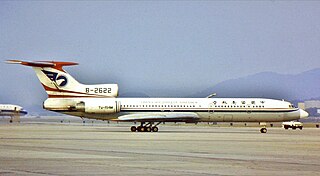
China Southwest Airlines Flight 4509 (SZ4509) was a domestic flight in China from Chengdu Shuangliu International Airport, Sichuan to Wenzhou Yongqiang Airport, Zhejiang. On February 24, 1999, the Tupolev Tu-154M operating the flight crashed while on approach to Wenzhou Airport, killing all 61 passengers and crew members on board.
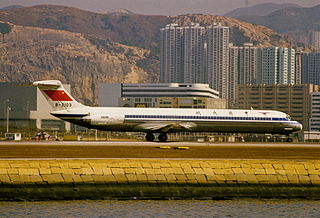
China Eastern Airlines Flight 5398 (MU5398) was a flight route from Shenzhen's Bao'an International Airport to Fuzhou Yixu Airport in Fujian. On 26 October 1993, a McDonnell Douglas MD-82 airliner flying this route crashed on approach to Fuzhou Yixu Airport. The aircraft overran the runway while landing in heavy rain and high winds. Two of the 80 passengers and crew on board were killed.
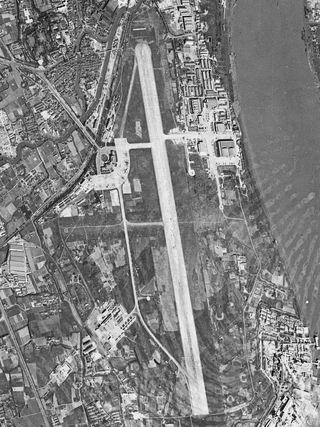
Shanghai Longhua Airport (上海龙华机场), then called Shanghai Lunghwa Airport, was a converted general aviation airport and PLAAF airfield located south of downtown Shanghai, China, on the bank of the Huangpu River. It opened in the early 1920s and served as the city's airport until the 1950s when Shanghai Hongqiao International Airport opened. Thereafter, it was one of two general aviation airports serving Shanghai and also served as an emergency landing site for police, fire and rescue operations southwest of the city. The airport was eventually closed at 1966, and the airport grounds were slowly built over though a period of between 1993 and 2016.

China Northwest Airlines Flight 2303 was a domestic flight from Xi'an to Guangzhou, People's Republic of China. On June 6, 1994, the aircraft operating the flight, a Tupolev Tu-154M, broke up in-flight and crashed as a result of an autopilot malfunction which caused violent shaking and overstressed the airframe. All 160 people on board were killed. As of 2024, it remains the deadliest airplane crash ever in mainland China.

CAAC Flight 3303 or China Southern Airlines Flight 3303 was a scheduled domestic passenger flight from the former Guangzhou Baiyun International Airport to Guilin Qifengling Airport, China. It was serviced by a Hawker Siddeley Trident, registration B-266, that crashed into a mountain on 26 April 1982, killing all 112 people aboard.

CAAC Flight 301, a Hawker Siddeley Trident operated by CAAC Guangzhou Regional Administration from Guangzhou Baiyun to Hong Kong Kai Tak, ran off the runway in Hong Kong on 31 August 1988 after clipping approach lights. This was the first accident of China Southern Airlines since the split of CAAC Airlines from 1 July 1988. Six crew members and one passenger perished in the accident. The crash shut down Kai Tak Airport for more than six hours after the accident.

Korean Air Cargo Flight 6316 (KE6316/KAL6316) was a scheduled Korean Air Cargo freight flight from Shanghai to Seoul. On 15 April 1999, the McDonnell Douglas MD-11F operating the route, registered as HL7373, crashed in Xinzhuang, Shanghai shortly after taking off from Hongqiao Airport, killing all 3 crew on board, along with 5 on the ground.

CAAC (中国民航), formerly the People's Aviation Company of China (中國人民航空公司), was the airline division of the Civil Aviation Administration of China and the monopoly civil airline in the People's Republic of China. It was founded on 17 July 1952, and merged into CAAC on 9 June 1953. In 1988, the monopoly was broken up and CAAC was split into six regional airlines, which later consolidated into China's Big Three airlines: Beijing-based Air China, Guangzhou-based China Southern Airlines, and Shanghai-based China Eastern Airlines.

China Eastern Airlines Flight 5735 was a scheduled domestic passenger flight from Changshui International Airport, Kunming, to Baiyun International Airport, Guangzhou in China. On 21 March 2022, the Boeing 737-89P aircraft descended steeply mid-flight and struck the ground at high speed in Teng County, Wuzhou, Guangxi, killing all 132 passengers and crew on board. Multiple reports say that the airplane was deliberately crashed, but the official investigation by the Civil Aviation Administration of China (CAAC) is ongoing. It is the third deadliest air crash in China after China Southern Airlines Flight 3943 and China Northwest Airlines Flight 2303, the deadliest air accident in China Eastern Airlines' history, and the deadliest plane crash in 2022.
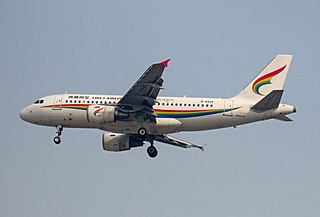
Tibet Airlines Flight 9833 was a scheduled commercial passenger flight in China from Chongqing to Nyingchi by Tibet Airlines. On 12 May 2022, the A319-100 aircraft operating the service suffered a runway excursion, causing both engines to separate, followed by a fire near the front of the aircraft. 36 people were injured during the evacuation.
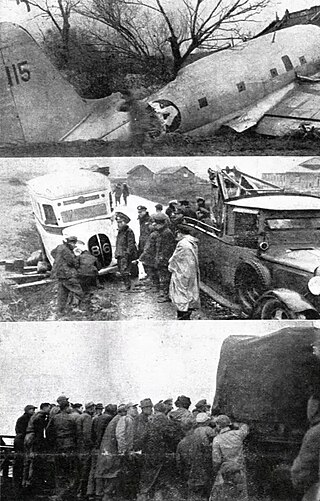
The Black Christmas disaster was a series of air crashes that took place in Shanghai, China, on 25 December 1946. This event involved three out of the four flights scheduled for Shanghai that day, including CA 48, CNAC 140, and CNAC 115. These crashes were primarily attributed to extremely poor visibility conditions due to foggy weather. As a result, the air crashes disaster claimed the lives of 74 and resulted in 8 injuries.

